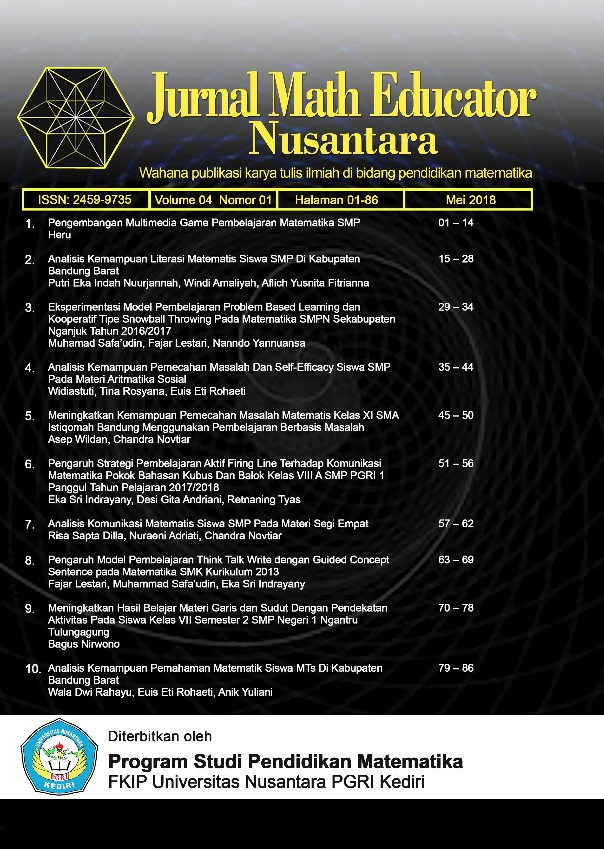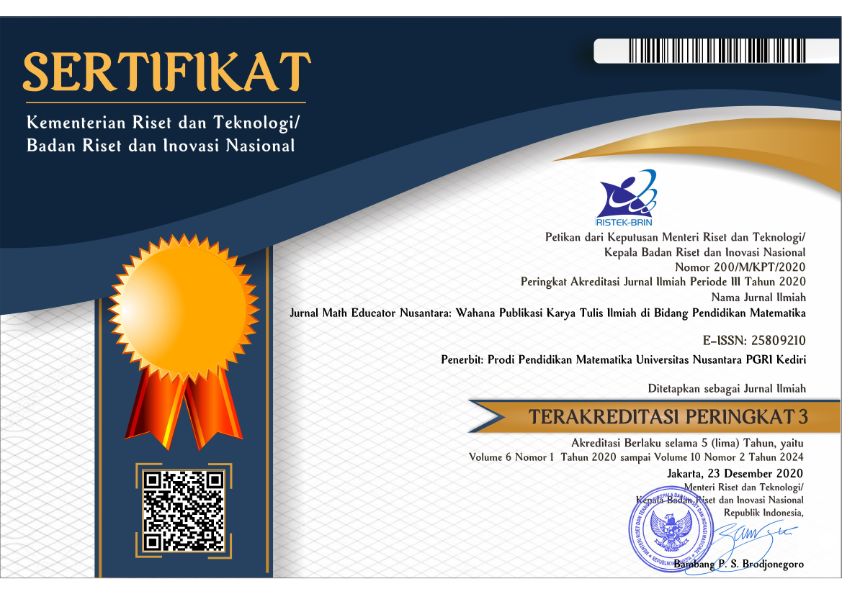Meningkatkan Kemampuan Pemecahan Masalah Matematis Kelas XI SMA Istiqomah Bandung Menggunakan Pembelajaran Berbasis Masalah
DOI:
https://doi.org/10.29407/jmen.v4i01.12001Keywords:
Mathematical problem solving ability, Trigonometry, Problem based learningAbstract
In purpose of learning mathematics exist one aspect must be improved is mathematical problem solving ability. But in fact, a level of students’ ability in pertained to weak. A trigonometry is one of the material which is quite difficult understood students XI grade in SMA ISTIQOMAH Bandung. It is need to be held a solution in learning that is using Problem Based Learning (PBL). This research using the method classroom action research with two cycles, which each cycles has two meetings. At the end of each cycle, students are given a written test in the form of a description. The result of research, show an increase on the mathematical problem solving ability by applying PBL. Seen from the results of the average score on each cycle, pre-cycle results with a score 37, in cycle one the score becomes 69 (42,30%), and in cycle two the score becomes 77 (69,23%).
References
Husna, M. (2013). Peningkatan Kemampuan Pemecahan Masalah dan Komunikasi Matematis Siswa Sekolah Menengah Pertama Melalui Model Pembelajaran Kooperatif Tipe Think-Pair-Share (TPS). Jurnal Peluang Volume 1, Nomor 2, April 2013, ISSN: 2302-5158.
Siregar, N.C, Marsigit. (2015). Pengaruh Pendekatan Discovery yang Menekankan Aspek Analogi Terhadap Prestasi Belajar, Kemampuan Penalaran, Kecerdasar Emosional Spiritual. Jurnal Riset Pendidikan Matematika. Volume 2 Nomor 2. Halaman 225.
Sumarmo, U. (2012). Bahan Belajar Mata Kuliah Proses Berpikir Matematis Program S2 Pendidikan Matematika STKIP Siliwangi. Bandung : Tidak Diterbitkan
Tanti, R. (2010). Kompetensi Berpikir Kritis dan Kreatif dalam Pemecahan Masalah Matematika di SMP Negeri 2 Malang. Jurnal Scientific
Trianto. (2009). Mendesain Model Pembelajaran Innovative. Progresif. Surabaya: Kencana Prenada.
Yuhasriati. (2012). Pendekatan Realistik dalam Pembelajaran Matematika. Jurnal Peluang dari Unsyiah. Vol.1-No.1 2012. (Februari 2017).
Downloads
Published
Issue
Section
License
Authors who publish with this journal agree to the following terms:
- Copyright on any article is retained by the author(s).
- The author grants the journal, the right of first publication with the work simultaneously licensed under a Creative Commons Attribution License that allows others to share the work with an acknowledgment of the work’s authorship and initial publication in this journal.
- Authors are able to enter into separate, additional contractual arrangements for the non-exclusive distribution of the journal’s published version of the work (e.g., post it to an institutional repository or publish it in a book), with an acknowledgment of its initial publication in this journal.
- Authors are permitted and encouraged to post their work online (e.g., in institutional repositories or on their website) prior to and during the submission process, as it can lead to productive exchanges, as well as earlier and greater citation of published work.
- The article and any associated published material is distributed under the Creative Commons Attribution-ShareAlike 4.0 International License
















